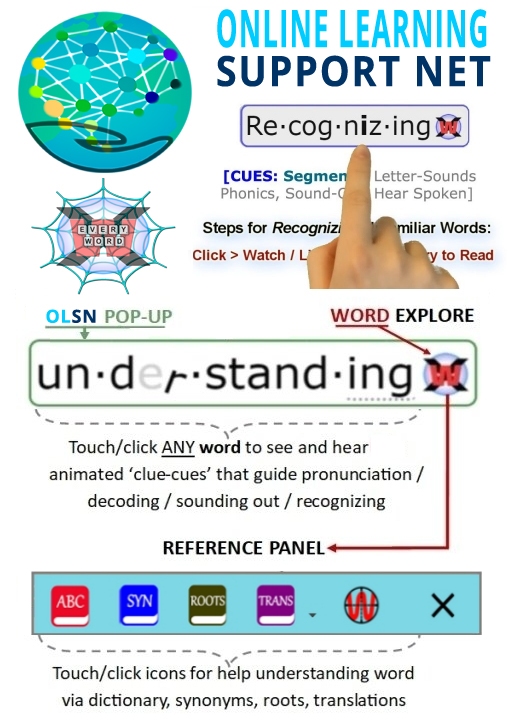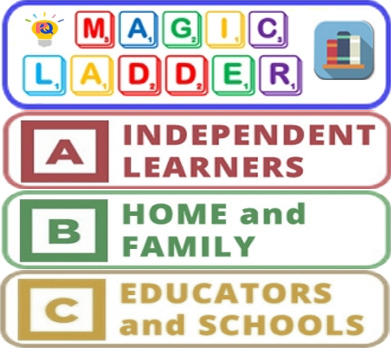Juvenile Justice, Special Education & Reading
Note: Remember to click on any word on this page to experience the next evolutionary step in technology supported reading.
Prison Cells and Reading Scores
David Boulton: We were interviewing Lesley Morrow, the Past-President of the International Reading Association, and she made a statement which flabbergasted me. She said this was a fact: that there are some states that determine how many prison cells to build based on reading scores.
Dr. Grover (Russ) Whitehurst: Yes. Again, the predictability of reading for life success is so strong, that if you look at the proportion of middle schoolers who are not at the basic level, who are really behind in reading, it is a very strong predictor of problems with the law and the need for jails down the line.
Literacy for societies, literacy for states, literacy for individuals is a powerful determinate of success. The opposite of success is failure and clearly, being in jail is a sign of failure.
People who don’t read well have trouble earning a living. It becomes attractive to, in some cases the only alternative in terms of gaining funds, to violate the law and steal, to do things that get you in trouble. Few options in some cases other than to pursue that life. Of course reading opens doors.
Grover (Russ) Whitehurst, Ex-Director (2002-08), Institute of Education Sciences, U.S. Department of Education. Source: COTC Interview:
http://www.childrenofthecode.org/interviews/whitehurst.htm#PrisonCellsandReadingScores
Prison Cell Building Based on Literacy Rates
David Boulton: Now I’d like to invite you to go into this question that I asked earlier about the relationship between learning disabilities in the field and reading, and reading as a learning-disabling process for those that don’t get it.
Rick Lavoie: Right.
David Boulton: To an extent that it’s just mind-boggling to me, when we look at the various things children are at risk for, that they might develop that could do harm to their lives, that could diminish their potential in life, the risk of having some reading-related difficulty that can harm their life is greater than everything else we pay attention to combined.
Rick Lavoie: Absolutely. Reid Lyon talks all the time about the number of states in the United States who use reading skill levels in third grade to project how many prisons they’re going to need twenty years down the line. That’s horrifying to think of that, but they really do. Their prison-building programs are based on the literacy rates in the third grade and they’re figuring in twenty years they’re going to need this many prisons based on the number of kids who can’t read in third grade. That’s how close the correlation is. That’s how real the correlation is.
David Boulton: What we’re basically saying is this comes back to the shame avoidance, the kind of things that you’ve been talking about. What we’re saying is that children that struggle with learning to read become self-disabled in some ways. Their relationship with themselves becomes disabled. They become more prone to social pathology, and it radiates, at massive expense to our society as a whole and to our population as a whole, to such an extent that this is the nation’s greatest learning disability.
Rick Lavoie: There are a number of schools within the field of education; in terms of the way we view the relationship between reading and learning. I come from the school where the inability to read is a symptom of a larger language problem. The overwhelming majority of kids who have difficulty, who have learning problems, have difficulty reading. And the overwhelming majority of kids with reading problems also have learning problems. So, I have a difficult time teasing the two of them away because they are so fundamental and so interlocked.
Rick Lavoie, L.D. and Special Education Professor, Source: http://www.childrenofthecode.org/interviews/lavoie.htm#PrisonBuildingPrograms
Special Education and Juvenile Corrections
David Boulton: Is there any other statistical things that you could summarize that would help in the case making side of this.
Dr. Peter Leone: I can give you some information about a national survey we conducted a couple of years ago that might shed some light on this, David. My colleagues at American Institutes for Research and at Arizona State and I and several other folks, with some federal support, surveyed juvenile correctional facilities, detention centers and state departments of education, to ask about how many kids who were confined were receiving special education services. There’s been pretty unreliable data on the prevalence of kids with disabilities or kids eligible for special ed services in juvenile corrections. Whether one accepts that there’s over or under-identification of kids, the issue is these are kids that somebody has recognized are not making it in the general ed curriculum, not making it pretty seriously.
So what we found was that about thirty-four, thirty-five percent of all kids are identified and receiving special ed services in juvenile corrections. Now, that’s about three times the number that you find in public schools. But the other side of that is that we had four states, I believe, that reported more than fifty percent of the kids that they serve were special ed eligible. Now, these are kids who came from the public schools and had been enrolled in special education. Again, whether or not that eligibility — whether or not there’s problems with that or not, it’s kind of a proxy…
David Boulton: It’s still a rough order of magnitude of saying that there’s a distorted relationship that’s going on, and that’s obvious.
Dr. Peter Leone: Absolutely. I mean, if you have a disabling condition, if you’re an African American youngster, and if you’ve experienced school failure, you’re at great risk for involvement in the juvenile justice system.
Let me share one other little piece of information with you, David.
David Boulton: Please.
Dr. Peter Leone: We’ve been looking at the suspension rates in Maryland for the last few years and we’re trying to look at vulnerabilities of kids and the relative risks that various kids face.
Peter Leone, Professor of Special Education at the University of Maryland; Director of the National Center on Education, Disability, and Juvenile Justice. Source: COTC Interview – http://www.childrenofthecode.org/interviews/Leone.htm#SpecialEducationandJuvenileCorrections
Juvenile Justice, Special Education and Reading Difficulty
David Boulton: That’s quite a story. Thank you. Going back to the beginning of that, it sounds like when you first brought Mike Brunner in at the National Institute for Education that you discovered this pattern that so many of the troubled areas in education had their roots in reading?
Robert Sweet: Right.
David Boulton: And then Mike was able to bring together the correlations in a way that was compelling.
Robert Sweet: Yes, he did, and he backed it up with documentation. I used to teach physics when I was a high school teacher back in the 1960’s. My background was in science, and I think that may have contributed to the fact that I was looking for evidence. I really didn’t have, as they say, a dog in that fight. If someone could have demonstrated or proven that learning to read was a natural process like learning to speak and that really, you could just surround people with books and that they’d automatically pick it up. It would have been fine with me if that could have been demonstrated in research, but it was not. So Mike really provided me with a lot of good articles from many well respected researchers that validated the approach to reading instruction that we now know works.
David Boulton: And then again, at the Justice Department you saw a strong correlation between juvenile offenders and reading problems?
Robert Sweet: Yes. Seventy-five to eighty percent of the juveniles were unable to read (at least the statistics that Mike found out). When you can’t read, then you can’t do your schoolwork and you can’t get a good job, and you end up on the street getting in trouble. That goes for welfare recipients and it goes for really, the school drop-out population. Not learning to read has such profound effects on the younger population.
Even now with Special Education, according to the studies and statistics, I think it’s something like two to three million young people are placed in Special Education simply because they haven’t learned to read, not because they have any other physiological problems or emotional problems. It’s strictly because they haven’t learned to read. They get placed in Special Ed, and the statistics show that only two to three percent of the kids that get placed in Special Ed ever go on to higher education. So basically, you have a smart, intelligent individual who is locked out of the American Dream simply because they didn’t have the appropriate instruction in learning to read.
As I say, maybe because of my science background, it’s so logical, and it’s so easy to remedy this, this problem we have in America, and it doesn’t have to be expensive. We’ve reached a point now where we are using the tools of research, which we have to back up the claims that teachers thirty, forty, fifty years ago knew intuitively. They knew because they practiced that kind of instruction in the classroom, and it worked, and their kids learned to read and there wasn’t even a question about it.
I’ve read so many stories of Master Teachers, Hazel Loring comes to mind, she wrote a little book called “Blend Phonics”. Hazel was up in Minnesota or Wisconsin and she has a little booklet that I think is probably forty-five to fifty pages long, a little folded paperback, not even a book, it’s just a pamphlet, and included in that are really all of the information that one needs to teach a person to read. She was successful in teaching the students in her class to read over many, many years and she put it in a little booklet and shared that with people, and said that they could reprint it for free, as long as they would apply it. [Hazel Loring book available for free download] So, in other words, it doesn’t have to be an expensive proposition. It’s really the will to do it and becoming acquainted with the skills that are essential for the foundation, for training children to read.
Robert Sweet, Co-Founder, National Right to Read Foundation, Former Director for the National Institute of Education, Source: COTC Interview:
http://www.childrenofthecode.org/interviews/sweet.htm#JUVENILEJUSTICE
Juvenile Delinquency and Reading/Learning Problems
Rick Lavoie: The reading process is the first experience of failure that our children meet when they get to school. What begins to happen is as they become isolated from the other kids and they become rejected by parents and teachers, they can fall victim to all sorts of societal pathologies. We see a disproportionate number of kids with reading and language problems, and we see a disproportionate number of kids in populations of kids with eating disorders and juvenile delinquency.
There’s a judge in the state of Connecticut who is so convinced of the link between reading and language problems and delinquency that when she meets a child in juvenile court she will say to the attorney, to the prosecutor, ‘Does this child have a reading and language problem?’ If the prosecutor says yes, then the judge conducts the proceedings in her chambers. If the prosecutor says no, she conducts the hearing as she normally would. And if the prosecutor says, ‘I don’t know’, she says, ‘Find out,’ and adjourns the hearing until the prosecutor finds out.
We’re finding that with kids with reading and learning problems, for example, juvenile delinquency, is a strike one, strike two, strike three situation for our kids. They’re more likely to get involved in juvenile crime because they can’t get and hold jobs because of their reading and language problems. They need the money, so they’re more likely to get involved in juvenile crime. They’re more likely to get caught because they’re not real good at being bad. They don’t plan real well because of the learning and language problems. So, they’re more likely to get caught. And they’re more likely to get stiffer sentences from the judicial system because they don’t handle the proceedings really well. So, it really is a strike one, strike two, strike three.
You see a disproportionate number of learning disabled kids and kids with reading and language problems in populations of kids who abuse drugs, who abuse alcohol, self-abusive behavior, suicide. A startling statistic in California is that approximately nine or ten percent of the kids in Los Angeles County have severe diagnosed learning and language reading problems. However, between the years 1995 and the year 2000, of the school-age children in Los Angeles County who attempted suicide and were successful, almost sixty percent had a history of learning and reading and language problems. Now that, statistically, is almost mind-numbing. Do the math. It’s easily seven, eight times what it should be.
So, the inability to read because of language, whether it’s directly or indirectly caused by a learning and language problem, looms very, very large in the lives of these kids. It impacts their peer relationships, it impacts relationships with teachers, and it impacts their relationship to learning. The reading and the learning are so intricately tied together, it’s such a Gordian knot at this point, that attempts to untie them and separate them into the learning disabilities camp and the reading disabilities camp, I see as an exercise in futility. They’re so closely linked, and so closely tied together.
David Boulton: I appreciate where you’re coming from. Here’s some differences and distinctions that I would like to exercise. For example, you just made a ten percent quote in Los Angeles county. That’s true on the one hand. On the other hand, nationwide, eighty-eight percent of black fourth-grade children are below proficiency in reading. Eighty-eight percent. Eight times that number are at some degree of life risk here.
Rick Lavoie: What I said was, and I always make a point to say it, ten percent have diagnosed learning disabilities.
David Boulton: What we’re basically saying is that some are so severe and so obvious that we can put a label on them in this way. But nonetheless, some six to eight times that, on a national average, are struggling and they’re not getting the same degree of attention.
Rick Lavoie, L.D. and Special Education Professor, Source: http://www.childrenofthecode.org/interviews/lavoie.htm#JuvenileDelinquencyandReadingLearningProblems













